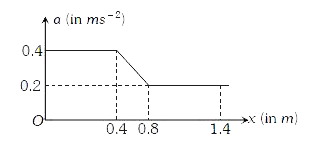The acceleration of a particle which moves along the positive x-axis varies with its position as shown in figure . If the velocity of the particle is 0.8ms−1 at x=0 , then find the velocity of particle when x = 1.4 s is ( in ms−1)

The correct Answer is:1.2
a=vdvdx
⇒∫vuvdv=∫1.40 a dx
⇒v2−u22= Area of a-x graph
⇒v2−(0.8)2=2(0.4)
⇒v=1.2ms−1
Similar Questions
A particle moves along the positive x -axis with an acceleration a_(x) which increases linearly with x , as shown in the graph. If the velocity of the particle at x=4cm is 0.40m//s determine the velocity at x=12cm
View SolutionThe velocity of a particle moving in the positive direction of X-axis varies as v=5√x. Assuming that at t = 0, particle was at x = 0. What is the acceleration of the particle ?
View SolutionThe velocity (upsilon) of a particle moving along X-axis varies with its position x as shown in figure. The acceleration (a) of particle varies with position (x) as
View SolutionA particle moves in the x-y plane with constant acceleration of4ms−2 in the direction making an angle of 60∘ with the x-axis, the particle is at the origin and its velocity is 5ms−1, along the x-axis. Find the velocity and the position of the particle at t=5s.
View SolutionA particle moves in the x-y plane with constant acceleration of 4ms−2 in the direction making an angle of 60∘ with, the x-axis. Initially the particle is at the origin and its velocity is 5ms−1 along the x-axis. Find the velocity and the position, of the particle at t = 5sec.
View SolutionA particle of unit mass is moving along x-axis. The velocity of particle varies with position x as v(x). =alphax^-beta (where alpha and beta are positive constants and x>0 ). The acceleration of the particle as a function of x is given as
View SolutionA particle is moving along the x-axis with an acceleration a = 2x where a is in ms^(–2) and x is in metre. If the particle starts from rest at x=1 m, find its velocity when it reaches the position x = 3.
View SolutionThree particles starts from origin at the same time with a velocity 2 ms^-1 along positive x-axis, the second with a velocity 6 ms^-1 along negative y-axis, Find the velocity of the third particle along x = y line so that the three particles may always lie in a straight line.
View Solution
